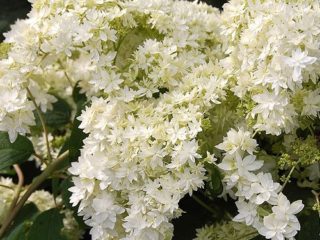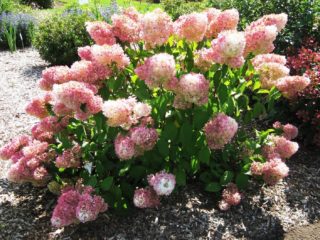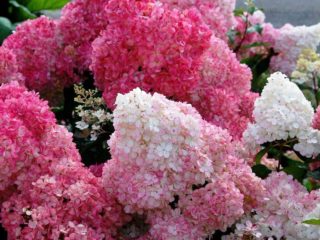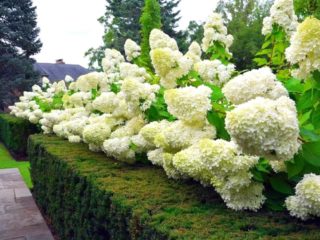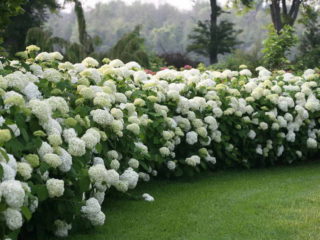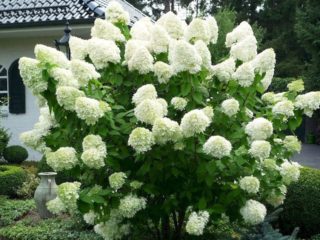Content
Hydrangea is highly decorative. Thanks to this, it is popular among gardeners. Many of them use a tree-like variety of shrub - hydrangea on a trunk. This method of forming a bush has a beautiful and well-groomed crown, dotted with huge inflorescences. It may seem too difficult to do this, but in fact, standard hydrangea is relatively easy to make with your own hands.
What does hydrangea on a standard mean?
In its ordinary form, hydrangea is a shrub up to 2 m high with one or two dozen straight branches, but slightly drooping at the ends. The standard variety has a central trunk, 30 to 150 cm long, branching from the top in the shape of a tree.
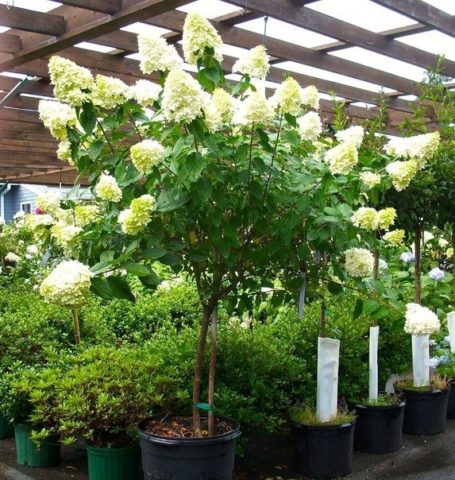
The root system of hydrangea allows you to grow tree-like varieties not only in open ground, but also in a separate container
Thanks to this “raising” of the bush above the ground level, the dimensions of the plant are reduced, it acquires a more compact and aesthetic appearance. Standard hydrangea bushes are widely used in landscape design.
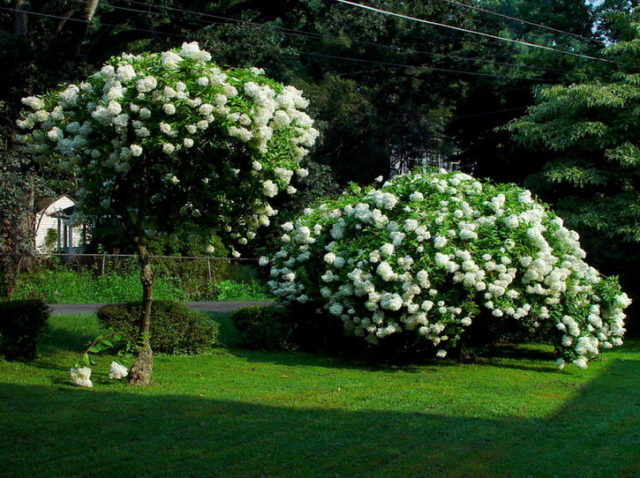
The main difference in the appearance of standard and bush hydrangeas is the shape of the crown
The best varieties of hydrangea for standard form
Currently, it is recommended to use three varieties of hydrangea for standard cultivation. Each of them differs in its characteristics and sizes.
Paniculata hydrangea
It is considered a universal option used in many design solutions. It has high frost resistance and produces abundant long-term flowering. The main shoots are very strong and can remain unchanged for a long time, which will be an additional advantage when forming a plant. Hydrangea paniculata on a trunk is shown in the photo below:
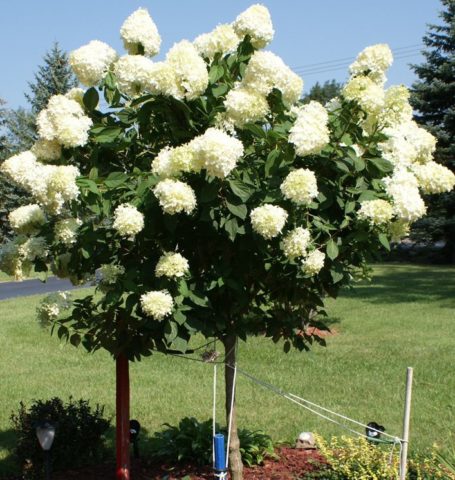
For normal development and life of the plant, the trunk must be directed vertically upward using rope spacers
Traditionally, this crop has a trunk height of 50 cm to 1 m. It is believed that standard paniculate hydrangea can survive for about 50 years. The total height of the plant can reach up to 4 m.
Grandiflora
A classic option used to obtain standard plants before the appearance of a large number of varieties of paniculate hydrangea. Until now, all new varieties bred are compared with Grandiflora. In its homeland (the countries of the Middle East) it can reach up to 10 m in height.

Grandiflora is a classic choice for forming a trunk, with a two-hundred-year history
The main problem of this variety is related to the fact that in temperate and even subtropical climates its bushes rarely reach a height of even 2.5 m. That is why the appearance of paniculate hybrids literally forced Grandiflora out of gardens and parks. However, if the difference in height of 1.5-2 m is not critical, this variety can also be used for the trunk.
PG (Pee-Gee)
The name is an abbreviation of Paniculata Grandiflora, which translates to "paniculate grandiflora". This fully reflects the type of culture in question. PJ is an improved version of Grandiflora, hybridized with one of the panicle hydrangeas. It is distinguished by abundant and long-term flowering, various shades of color, large and dense flowers.

PG trunks have the densest flower cover, behind which leaves are sometimes not visible
In addition, Pi-Gi has frost resistance down to -35 ° C, unpretentiousness and drought resistance. It is able to change its shade over time. At the beginning of flowering it is white, then pink, and at the end purple.
Other varieties
The varieties of hydrangea listed above are used most often, but the choice of variety for the standard is not limited to them. Today, varieties such as Vanilla Fraze, Pinky Winky, Kyushu, Phantom, and others can be used for such cultivation. Lime light.
It is believed that the listed varieties have a longer flowering time and a greater variety of shades compared to paniculate hydrangea.
Hydrangea on a standard in landscape design
This method of decorating a plant is an excellent decoration for the garden, which can be used in a wide variety of landscape design solutions:
- in various mixborders in combination with other ornamental plants;
- trunks with bushes of different shades will be used to create Japanese gardens;
- trees grown in separate containers can be used to decorate balconies, terraces, benches, and other recreation areas;
- standard hydrangea can be combined with ground cover plants;
- good combinations are obtained with low-growing conifers;
- hydrangea can be the center of a composition in a flower bed.
Depending on the height of the crown, standard plant varieties can be used for other tasks.
How to grow hydrangea on a trunk
Forming and growing such a plant is relatively simple. The only drawback of this variety is the rather long formation time, taking from 2 to 7 years. Below we discuss the features of growing standard hydrangea and caring for it.
Selection and preparation of a landing site
All the rules and conditions for growing artisanal hydrangeas are also suitable for standard hydrangeas. She needs an area located in partial shade with approximately equal periods of lighting and shading. The soil should be slightly acidic, moderately moist and loose.
Rules for planting standard hydrangea
Plants are planted at the beginning or end of the warm season. Moreover, spring planting will be more effective, since the bush will take root much faster. 3-4 weeks before planting, the soil on the site is dug up and fertilized with humus or compost.
The holes are made of such a volume that the root system of the seedling can be completely contained in them. The distance between adjacent plants for standard varieties should not be less than 2 m.

Hydrangea seedlings are often planted in open ground along with a lump of earth.
The seedling is placed in the center of the hole, its root system is straightened and evenly sprinkled with the excavated soil.Next, the soil is lightly compacted and the seedling is watered with one bucket of water. It is advisable to mulch a tree trunk circle about 1 m in diameter with peat 5-10 cm thick.
Caring for standard hydrangea
Caring for the plant includes regular watering, fertilizing and pruning the plant. But before all these procedures, the standard of the hydrangea should be correctly formed. Actually, it is this task that will be the most difficult of those that the gardener faces, since the rest of the care for the unpretentious plant is very simple.
How to form a hydrangea standard
You can form a plant in the first year of life. Some gardeners begin the process the second year as the hydrangea will have adapted and the branches will become thicker. In any case, the sequence of operations will be as follows:
- First, pinching is carried out in a standard form in the summer, namely: all lateral shoots and shoots are plucked out. The following season, at the same time, they are cut into a ring. Due to this, the trunk thickens.
- In order for the “main” trunk to become smooth and beautiful, in early spring it should be shortened to the first most developed bud. The formation of a trunk begins when the plant reaches a height of 100-150 cm.
- To evenly distribute the load on the main trunk and skeletal branches, hydrangea is formed into 2-3 trunks with a common crown.
By repeating these operations from year to year, after 5-7 years you get a full-fledged tree on a trunk, the care of the crown of which will mainly refer to cosmetic pruning.

The scheme for forming a trunk is simple and even a novice gardener can do it.
Pruning standard hydrangea in the fall is carried out according to the following scheme:
- young branches are removed immediately after flowering, this will allow new shoots to form before the onset of cold weather;
- remove all stems and branches growing inside the crown;
- Once every 3 years, lignified shoots are removed, this stimulates additional crown growth;
- Before wintering, remove diseased and damaged shoots.
In the spring, pruning standard hydrangea is primarily of a sanitary nature: diseased, dried and frostbitten branches are removed.
How to plant hydrangea on a trunk
Using this method, you can get not only paniculate, but also tree-like standard hydrangea. For this purpose, it is necessary to choose a rootstock that is sufficiently thick and healthy. Most often the plant of the same variety is used.
One or more splits are made in part of the trunk at a height of 0.5 to 0.7 m. In general, their number depends on the thickness of the rootstock and the number of scion branches present. According to the classic layout, 2 or 3 cuttings are used for grafting. Their length is selected within 10-20 cm and depends on the distance between the eyes. Each cutting must have at least 5 buds.
The grafting scheme is standard - the cuttings are deepened 3-4 cm into the split, tightly tying it around the perimeter with twine. Then all open areas are treated with garden varnish and wrapped with plastic film.
Whether the vaccination was successful or not will become clear in about a month. If buds begin to bloom on the cuttings, then everything went well.
Watering and fertilizing
The frequency of watering is determined by the degree of soil moisture.Regardless of whether mulching is used or not, the tree trunk circle should not remain dry. Usually one watering per week in the amount of 1-2 buckets per plant is enough.
Two feedings of the plant per season are enough. The first is aimed at stimulating vegetation. It is done in the spring, during the budding period. The optimal fertilizer in this case is urea in the amount of 20 g per 1 bucket of water. Traditionally, fertilizing is combined with watering. An adult plant will require two buckets of water with fertilizing, a young plant (up to 3 years old) will require one.
The second feeding is applied in the summer, during flowering. The optimal composition is a mixture of urea, superphosphate and potassium sulfate. The components take 30 g of each and dissolve in 1 bucket of water. In the fall, a third feeding in the form of manure or compost is acceptable.
How to cover standard hydrangea for the winter
Overwintering hydrangeas on a trunk can be carried out without covering the plant. It has sufficient frost resistance.
Conclusion
Hydrangea on a trunk is a beautiful element of landscape design that has a wide range of applications. It can be used both in a single planting and as part of complex compositions. Growing a trunk lasts several years, but in general, caring for hydrangea is relatively simple and unpretentious. Even a novice gardener can handle it.
Reviews of hydrangea on a standard

